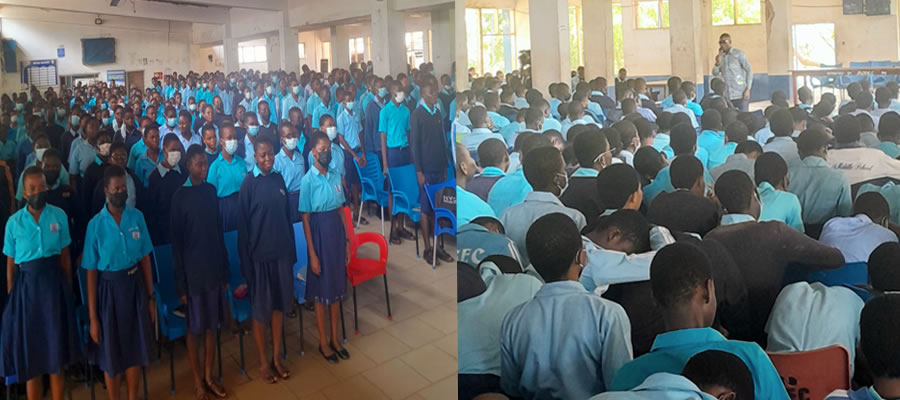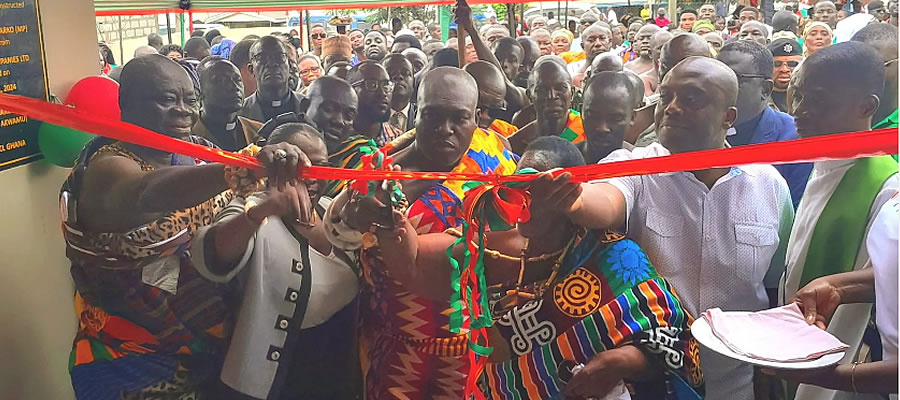

Introduction
This chapter deals with projections of population and all other sectors of the economy. Those of social development finance and economic projections follow the population projections for the District.
Population Projections
The paramount role of development planning cannot be overemphasized. Population in particular is at the centre of all planning activities. Estimates of demographic data both current and future periods, are essential tools in background studies for development planning since human resources and needs vary according to size, composition and population distribution.
This section gives the projected population for Asuogyaman District from 2001-2005. The projected population include those for total population, population by area council and the population by broad age groups.
Assumptions in Population Projections
Assumptions occupy an important position in Population projections since Projections deals with the future, which is unpredictable. These uncertainties have to do with changes in mortality, fertility and migration, which are the major determinants of population changes. It is thus imperative to state assumptions under which projections are made so that the future trends can be better appreciated.
One component of population change that rarely changes in Ghana and for that matter Africa is fertility. This is unlike both mortality and migration. Social attitudes and perceptions, which are deeply embedded in the Ghanaian Society, are responsible for this situation. It thus requires a relatively long period of time for population control policies to effectively impact positively on fertility in Ghanaian society.
The current regional fertility of 4.4 (according to the Demographic and Health Survey, 1998) which is closely and positively related to the district figure is assumed to drop to 4.0 in 2000 and remain constant during the projection period.
- Mortality
- A sustained yearly coverage in immunization of not less than to 70 percent of children of the age of immunization throughout the period of projections.
- Not less that 70 percent of the population are socially accessible to health services.
- A corresponding improvement in the access to other social services especially education.
Total Population Projection
Total population for the district is projected to increase from 74,142 in 2000 to 80719 in 2005. This projected population to 2009 is indicated in Table 9.1
Year | Population |
2001 | 75,564 |
2002 | 77,014 |
2003 | 78,491 |
2004 | 77,996 |
2005 | 81,531 |
2009 | 91484 |
Source; DPCU Projections, 2006.
Population By Broad Age Groups
The population projection was done for 0-14 years, 15-64 years and 65+ year’s age groups. This is intended to give a clear picture of the broad structure and composition of the Population in the district.
Year | 0-14 | 15-64 | 65 + |
2001 | 33,331 | 38,756 | 3,475 |
2002 | 33,971 | 39,500 |
|
2003 | 34,622 |
|
|
2004 | 35,286 | 41,030 |
|
2005 | 35,963 |
|
|
Source; DPCU Projections, 2006.
Population Projection of Area Council
Area councils in the district had their populations projected for the planned period. The population figure of all settlements in a particular Area council was added up to get the Area Councils total populations. Proportions were then used to project the 2001-2005 Population of the Area Councils
Area | 2001 | 2002 | 2003 | 2004 | 2005 | 2006 | 2007 | 2008 | 2009 |
Atimpoku | 19,057 | 19,423 | 19,795 | 20,175 | 20,562 | 21,165 | 21,765 | 22,253 | 22,876 |
Frankadua/Apeguso | 13,624 | 13,886 | 14,152 | 14,423 | 14,700 | 14,978 | 15,210 | 15,789 | 16,132 |
Anum | 7,254 | 7,393 | 7,535 | 7,679 | 7,827 | 8,134 | 8,765 | 9,224 | 9 ,789 |
Boso | 7,648 | 7,794 | 7,943 | 8,096 | 8,251 | 8, 720 | 8,974 | 9, 126 | 9,321 |
Akosombo | 18,626 | 18,984 | 19,348 | 19,719 | 20,097 | 20,567 | 20,754 | 21,147 | 21,576 |
Gyakiti | 9,355 | 9,534 | 9,718 | 9,904 | 10,094 | 10,457 | 10,940 | 11,290 | 11,790 |
Planning Implications of Population Projection
Table 9.2– gives credence to the fact that Asuogyaman District has a young population. The proportion of the population in the 0-14 year age bracket will average about 44.11 by 2005. Though this will mean a higher dependency ratio for the labour force it is also potential labour force which must be taken advantage of to foster development.
Again, a lack of corresponding increase in job opportunities to match the expected increase in the proportion of the 0-14 year age bracket - to ameliorate the already high underemployment and unemployment rate in the District - will result in the upsurge of social problems. Such problems include theft, prostitution and drug abuse and peddling.
Also an increased in the 0-14 year age bracket together with that of the potential labour force age bracket (this average will put pressure on existing social services and thus increase demand for social amenities. This will also result in the increase of pressure on land, subsequent deterioration of environmental condition and possibly result in land disputes, since the major economic activity in the district is farming.
Human Resource Development Projections
Introduction
The provision of social, technical or economical infrastructural services is based on a number of parameters. Paramount among these is population threshold and planning standards. An increase in population requires the provision of additional services to augment the strength of existing ones which might have been over-stretched.
It must however be stated that population alone is not the only factor considered, such that though an area might merit a facility considering its population, this might not happen as a result of other factors considered.
Monitoring and Evaluation
Monitoring is a process that ensures that at each stage of any given project, the required inputs are delivered on time, used as intended and is producing the desired results. Project monitoring starts with the actual implementation of the project. It is on-the-spot check to ensure that projects progress according to schedule, that standard of quality is respected and that delivery of inputs are timely. This is important since resources are used in specific combinations to achieve specific project results at a given point in time; Evaluation on the other hand, is conducted in greater detail at the project level.
It is usually done to assess whether resources invested have produced or are producing desired results and whether benefits are reaching the targeted population. To determine whether set targets have been achieved the causes of deviation if any, and how to counteract any unintended consequences, evaluation processes are undertaken. The main task of evaluation is therefore to give feedback which can lead to planning where necessary. Since plans are affected or modified by; (a) undersign changes in the socio-economic situation of the district or country, (b) political climate of the country and (c) international relations, it is necessary that they are constantly monitored and adjustments made accordingly.
Consequently, in the implementation of programmes and projects in this document, the District Planning and Co-ordinating Unit (DPCU) is responsible for the general monitoring and evaluation of this plan. However, actual project monitoring and evaluation are the responsibility of Sector Departments and NGOs implementing these projects as it has been indicated against each project. Monitoring and Evaluation reports from against each project. Monitoring and evaluation reports from sector departments and the DPCU should be co-ordinated by the DPCU and presented to the executive committee of the Assembly periodically.
The National Development Planning commission (NDPC) and Regional Co-ordinating Council (RCC) shall also monitor periodically projects undertaken in the District and especially financed from the District Assemblies Common Fund. Prescribed formats for monitoring and evaluation of District projects are yet to be finalised by the NDPC for the districts. When such formats are ready the District Assembly through its DPCU shall be expected to follow these formats for project monitoring and reporting accordingly. Monitoring and Evaluation reports should be prepared in accordance with the format recommended by the NDPC. Detailed monitoring and evaluation plan would be prepared for the 2006-2009 District Medium Term Plan.
Date Created : 11/23/2017 4:34:33 AM












 facebook
facebook
 twitter
twitter
 Youtube
Youtube
 +233 593 831 280
+233 593 831 280 0800 430 430
0800 430 430 GPS: GE-231-4383
GPS: GE-231-4383 info@ghanadistricts.com
info@ghanadistricts.com Box GP1044, Accra, Ghana
Box GP1044, Accra, Ghana